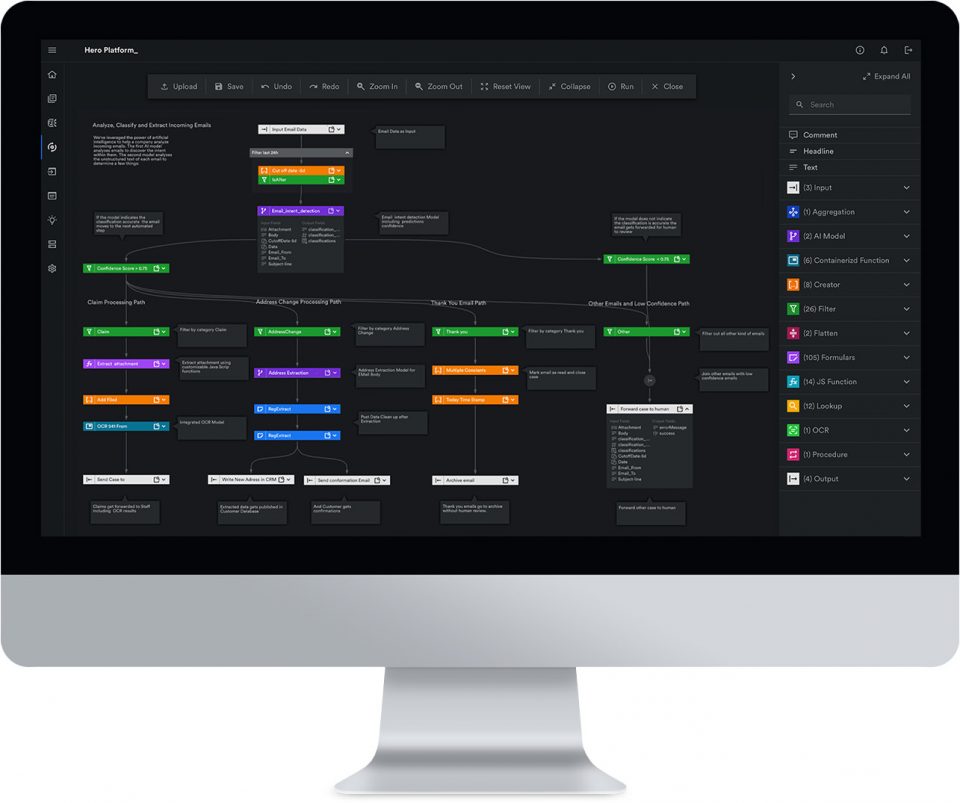How to automate your finance processes — a guide to modern finance automation in 2023
After discussing the automation potential with CEOs and CFOs, we reached a simple conclusion: modern AI will revolutionize the way finance processes are automated. Read more to discover how the needs of modern financial process automation can be met in 2023 and beyond.
Apr 24, 2023 by Craig Woolard

It’s hard to argue with the success of automation in finance operations.
In an Oxford Economics survey, 73% of finance and banking leaders agreed that automation improved efficiency and gave executive staff more bandwidth to focus on higher-value strategic tasks. And yet, almost 90% of the CEOs surveyed said they needed a more agile approach to analyzing financial and performance data.
Keep in touch
It seems that traditional automation vendors fail to understand the real-world needs of their customers.
At Automation Hero, we have evaluated hundreds of business problems with finance and banking customers worldwide. After discussing the automation potential with CEOs and CFOs, we reached a simple conclusion: modern AI will revolutionize the way finance processes are automated.

What is modern finance automation?
Finance automation uses software and technology to streamline repetitive tasks in essential financial business processes. The main goal of automation is to eliminate errors and inefficiencies so that employees can spend more time on strategic tasks.
A combination of technologies can drive the modern automation of manual work involved in financial workflows. Artificial intelligence (AI), robotic process automation (RPA), intelligent document processing (IDP), machine learning (ML), and natural language processing (NLP) all help eliminate much of the tedious work performed by members of finance teams and other departments.
Of course, this doesn’t mean humans are left out of the process. As with any finance automation software, it’s critical to understand what you can and should automate first.
Understanding what can be automated
According to a McKinsey Global Institute report on the future of finance automation, current automation technologies can fully streamline nearly half of an organization’s financial activities.
The research also pointed out the daily work activities that are the easiest to automate, including:
- General accounting tasks
- Payroll
- Accounts payable
- Accounts receivable
- Tax Solutions
- Reporting and analysis
- Risk Management and auditing
- Fraud Prevention
The research in the McKinsey report estimates that “about a third of the opportunity in finance can be captured using basic task-automation technologies such as robotic process automation (RPA).”
The remainder of the opportunity requires more advanced cognitive automation technologies, such as intelligent document processing (IDP), that tap into powerful machine-learning algorithms and natural-language capabilities.

What are the limits of legacy automation software?
By the mid-2010s, much of the “busy work” involved in automated financial systems had been taken over by RPA bots. For example, RPA bots attempted to handle data entry, price matching, and purchase order processing. But they were often unable to manage the entire workflow. RPA breaks easily and is difficult to update whenever modern, evolving work processes change.
RPA runs on top of existing IT systems as a complementary automation solution; however, as a legacy “rules-based” technology, RPA has earned a reputation in the banking world for being “fragile” and inflexible to maintain.
For example, invoice processing, underwriting, ESG reporting, and customer service are all major areas where traditional RPA falls short and requires significant human intervention.
Today, legacy RPA can still handle some of the rote busywork involved with simple accounting tasks. However, RPA struggles with complex financial processes such as those involving:
- Risk management
- Fraud prevention
- KYC/AML/ESG compliance
- Customer support
- Underwriting
- Reporting analysis
These financial services are just too complex for traditional “rules-based” approaches.
Providing customer support, responding to emails, approving applications, and organizing paperwork significantly impact customer satisfaction — especially as front-end processes become more accessible and faster, thanks to the competition from more responsive fintech apps.
Watch this demo to learn more about invoice process automation and where RPA falls short.
Why financial services need modern AI
For nearly a decade, it’s been clear that RPA is no longer enough. How, then, can the rest of the grueling manual work be automated?
Today’s competitive landscape requires finance automation software with next-gen AI/cognitive intelligence to extract data from documents with above-human accuracy.
For example, ESG (environmental, social, and governance) reporting is a complex reporting process that involves converting structured and semi-structured data from various sources into detailed compliance reports.
Intelligent document processing (IDP) is one example of modern artificial intelligence in the automation workflow that can handle these unstructured documents like a tenured finance expert.
IDP uses AI, machine learning, and Computer Vision to “read” financial documents with above-human accuracy, extract critical data points for complex financial reporting tasks, and more.
For example, in invoice processing, a modern AI approach like IDP doesn’t mind if the layout of incoming invoices changes. This is because an AI-powered workflow driven by IDP actually “learns” the structures of each invoice — just like a human would — and processes them no matter which vendor sends the invoice.

What is the best finance automation software?
Every organization has decision-makers with the authority to approve or deny payments. Procurement managers, accounting departments, CFOs, and VPs are often involved in this complicated workflow.
This makes automation even more complex for large enterprises looking to streamline their financial activities efficiently. That’s why modern financial process automation needs more than AI. It needs to enable critical decision-makers to be in the automation loop.
When understanding what finance automation might look like beyond 2023, closing the gap between your people and your automation is essential.
Automation Hero’s IDP platform offers end-to-end financial document intelligence. It sorts financial documents into categories and extracts the essential data. Hero Platform_’s full-service IDP technology connects with existing applications and databases to make the data immediately available to those who need it.
1. What are the key benefits of finance automation?
The benefits of financial process automation are undeniable. With the advances in modern artificial intelligence, there is now more opportunity than ever for organizations to undergo a full digital transformation. The benefits include:
2. More time to focus on strategic work
Modern automation with intelligent document processing takes care of the technical “busywork.” With IDP, finance teams are freed to focus on higher-level strategic tasks. IDP allows leaders to build stronger relationships with clients, partners, and employees. It also ensures proper supervision of accounting and frees up more time for employees to focus on strategic work.
Want more productive, happier teams? Then, check out our blog on the benefits of automation for employees to learn more.
3. Reduce human error
Manual data entry can lead to human errors that are expensive to fix. The transaction itself is the basis of every professional relationship. Journal entry discrepancies and missed bill payments cause significant disruptions to the transaction. Digitizing processes through automation eliminates human error and ensures consistent, reliable workflows.
4. Improve data quality
It’s no secret that speed and productivity increase whenever manual processes and human touchpoints are cut back or removed. However, the effect on accuracy and data quality is also significantly improved with automation. Bad data tarnishes your company’s reputation. Accurate and consistent information helps teams communicate better and enhances decision-making. Reliable data benefits everyone involved.
5. Increase operational efficiency
Our financial process automation solution offers an easy-to-use human-in-the-loop interface that enables multi-party reviews and approvals. Automation Hero’s Hero Platform_ turns randomized audits, compliance procedures, and QA processes into streamlined collaborations. Integrating your existing databases and financial tools into the automation workflow enables deeper collaboration between departments and the decision-makers in your organization
6. Enhance decision-making
Some automated financial systems can connect with existing applications and databases to make the data readily available. For example, complex AP processes require collaboration between different departments and systems. Our platform’s API enables this seamless integration with third-party services, such as bookkeeping software, payment systems, and email providers. With our platform, you can confidently make decisions, update ledgers, remit payments, and notify vendors that an invoice is under review — all from one place.

How to set up finance automation?
There is no “one-size-fits-all” solution for automating financial services. However, understanding what can be automated when developing an implementation strategy that will meet your organization’s goals is critical.
Automation Hero is the only end-to-end platform that deploys automation and document AI processes as highly scalable and reliable micro-services. There’s no need to “rip and replace” with Automation Hero’s IDP. Hero Platform_ integrates with and upgrades existing ERP, SAP, DMS, EDI, and AP systems. For example, supercharge an ERP system with intelligent document understanding or augment your current RPA with AI capabilities.
You can immediately start using Automation Hero’s built-in intelligent document processing to build an automated infrastructure that speeds up the workflow at every step. In addition, our API will serve as an intelligence “fabric” that allows you to connect all your micro-services with other automation and internal data systems.
Unlock the intelligence in your financial documents with AI-driven automation today
- Speak with an expert — tell us about your specific use case.
- Get a personalized demo — schedule a demo, and our Heroes will get in touch!
Close Window
Automation Hero will track how you use the emails (e.g., at what time you open which part of the emails) sent by Automation Hero. If you have provided a separate declaration of consent that cookies for tracking your usage of the website and/or apps may be placed on your device, Automation Hero will also connect the information about your use of Automation Hero’s websites and apps (e.g., which information you open) collected by the tracking cookie to such information in so far as possible. Automation Hero will analyze such information, to identify your interests and preferences and to communicate with you in a more personalized and effective way, e.g. by providing information that you are likely interested in, like information on new technologies or products of the Automation Hero group that are likely relevant to you.
